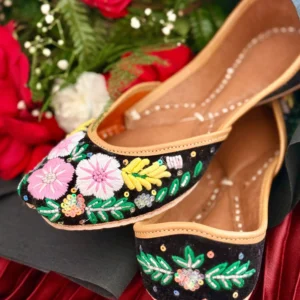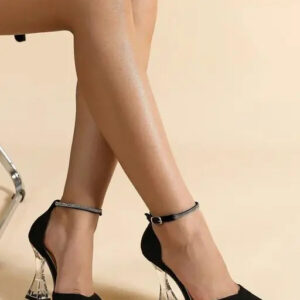
Jutti Making in Punjab
Introduction:
Jutti making in Punjab is not just a craft. A perfect mix of tradition and culture which is equally loved by the people of all ages, ‘Jutti’ is derived from an Urdu word for a shoe. This type of shoe has a closed upper and is slipped-on. It is most commonly associated with Punjab and mostly worn in North India. Punjabi juttis were originally made out of leather and their uniqueness comes from the embellishments and embroidery. It is symbolic to genuine and ethnic transferred generation by generation and forms a vital component of the traditional Punjabi culture. Even in the present day modern world juttis are regarded as an essential ethnic wear and they have earned their own niche. Since they can be worn daily, to any function and are still regarded as a vital component of the traditional functions like weddings.
Usage
Worn by both men and women, Punjabi juttis come in distinct styles for each gender. Gabroos (Punjabi men) often prefer the Khussa jutti, which features an upturned curl at the toe—symbolic of the traditional kundi mooch (curled mustache), a mark of masculine elegance. In contrast, Mutiyaars (Punjabi women) are drawn to the Kasoori jutti, known for its delicate, feminine patterns that reflect grace and charm.
Juttis designed for special occasions are often richly embellished with heavy embroidery, mirrors, sequins, and sometimes even ghunghroos (anklet bells), adding festive sparkle.
While traditionally worn with Indian attire, today’s juttis have evolved to match modern, global fashion sensibilities. They are now styled with everything from ethnic outfits to skirts, cocktail dresses, sarees, and even shorts, offering immense versatility.
Modern designs include:
- Pastel juttis with floral prints
- Geometric patterns
- Textile-based designs featuring ikat, bandhani, and phulkari embroidery
With juttis available for nearly every occasion, they allow for endless styling possibilities—from casual chic to traditional elegance.

Significance
Punjabi juttis are more than just footwear—they’re a cultural emblem. Deeply rooted in Punjabi tradition, they signify collective identity and ethnic pride. As the traditional footwear of North India, juttis have long been associated with both daily wear and ceremonial occasions.
Originally crafted entirely from locally sourced leather, juttis evolved over time due to regional variations in climate, materials, and craftsmanship techniques.
Punjab remains a major hub for jutti production, with Patiala standing out as a key center. Among its most renowned offerings is the Tilla jutti, also known as the Shahi jutti, named for its luxurious embellishments and royal heritage. These juttis were famously worn by Delhi’s kings during the Khilji and Lodhi dynasties.
Other notable jutti-making regions in Punjab include:
- Ludhiana
- Muktsar
- Faridkot
- Malout
Each area brings its own unique flair to jutti design, adding to the art form’s diversity. The intricate craftsmanship and heritage value of traditional juttis make them treasured artworks and a proud symbol of Punjabi culture.

Myths & Legends
Legend has it that the earliest royal footwear was intricately embroidered using real gold and silver threads. The artisans behind this exquisite work hailed from the neighboring state of Rajasthan. According to folklore, the royal family of Patiala invited these skilled craftsmen to Punjab to create customized footwear exclusively for the court.
One of the most prominent stories centers around Maharaja Bhupinder Singh, one of Punjab’s most flamboyant and well-known rulers. He married the sister of Ganga Raj Singh of Rajasthan and, during a visit to her homeland, was captivated by the craftsmanship of the Rajasthani mochis (shoemakers). So impressed was he by their skill that he invited them to settle in Patiala, where the art of jutti-making took root and flourished.
History
Ancient Roots
Footwear in India dates back to ancient times, with references found in sacred texts like the Yajurveda Samhita and the Atharva Veda, where a type of shoe called Upanah is mentioned—worn by Brahmins and Vratyas during rituals. Early shoes were made of wood, antelope hide, bear-skin, palm leaves, and other natural materials.
Before 600 BCE – Ancient Period
Footwear was typically simple: sandals or slip-ons made from plant fibers and leather. Regional styles varied based on terrain and climate.
Maurya and Gupta Empires (322 BCE – 550 CE)
More refined styles of footwear emerged, with leather being commonly used. Footwear began to reflect social status and profession.
Medieval Period (600 CE – 1200 CE)
Islamic influence brought pointed shoes, slippers, and ornate boots. Footwear evolved with improved craftsmanship and decorative styles.
Mughal Era (1526 – 1857)
This era marked the golden age of jutti design. The Mughals introduced luxurious styles adorned with zari, zardozi, pearls, and gemstones. Juttis became a staple of royal fashion and were crafted using premium leather. The name Salim Shahi juttis is said to originate from Salim Shah, who popularized the curled-toe design in the early 16th century.
By the time of Emperor Jahangir, mojris with inverted toes became prominent. These shoes, which were originally worn by royalty, became symbols of prestige and refinement.
Colonial Period (1600s – 1947)
British colonialism brought European-style footwear to India, but traditional juttis continued to be worn, especially for cultural and religious functions.
Post-Independence (1947 Onwards)
India’s footwear industry modernized, introducing mass production. Still, handcrafted juttis maintained their cultural importance and saw a revival in fashion, blending tradition with contemporary style.
The Role of Rajasthan and Punjab
Before the Partition, while chamars (those who processed raw leather) were found across India, the mochis (shoemakers specializing in leather goods) were predominantly settled in Rajasthan. Royals across the subcontinent invited these artisans to craft footwear for their courts—especially the embellished juttis, which became coveted status symbols.
Eventually, many mochis migrated and settled in regions like Punjab, Haryana, and Pakistan, where the craft was further honed. Patiala, in particular, became a key center of innovation. The royal family’s favorite, the Tilla jutti, was richly adorned with gold and silver thread, giving rise to the now-iconic Patiala jutti.
The Kasur Connection
The very first jutti is believed to have been made in Kasur (now in Pakistan) during the Mughal era. While the general population wore simple leather footwear, royalty desired something more extravagant—thus, juttis featuring precious gems, intricate embroidery, and fine leather came into being.
Conclusion
The Punjabi jutti has traveled through centuries of history, influenced by dynasties, cultures, and kingdoms. Today, it continues to reflect the region’s heritage, artistry, and identity, standing tall as a testament to timeless craftsmanship.

Design
The Crafting Space: A Family Affair
Jutti-making is a traditional, home-based craft, where the artisan’s workspace is often an extension of their living quarters. Historically, this has been a family-run effort, with defined roles—men crafting the shoe structure, and women embellishing them with embroidery and decorations.
Even today, in regions where production has shifted to small workshops, women often take juttis home to work on their embroidery. It’s a social and collaborative activity—groups of women gather in courtyards, stitching and chatting in a relaxed environment after completing household chores. This work provides a valuable source of supplementary income, while also preserving community traditions.
Structure and Style
The traditional Desi Punjabi jutti features:
- A flat sole with no distinction between left and right foot.
- An M-shaped front, known as the Panna, which is the focal point of decoration.
- Embellishments that may expand to the sides or even the back of the jutti.
- Some styles include a closed, rounded tip, resembling a modern ballerina shoe.
Design Influences
Jutti designs are inspired by Mughal architecture and nature, especially the visual language of Rajasthan. Common themes include:
- Tessellated patterns reminiscent of Mughal monuments.
- Motifs of birds, flowers, and foliage.
- Use of blue threads symbolizing the open sky.
- Embellishments like mirror work, gems, beads, and zari.
While men typically wear more minimal, rugged designs, women’s juttis are known for their intricate and colorful embroidery.
Types of Juttis
Here’s a guide to both classic and contemporary styles:
Traditional Styles
- Tilla Jutti
Signature of Patiala, known for gold thread work (zari). Highly ornamental and worn during celebrations. - Salemshahi Jutti
Features a pointed or curled toe and a spade-shaped sole. Named after Prince Salim (Emperor Jahangir). - Khussa Jutti
Worn by men, featuring a curled tip symbolizing masculinity. Also called Sardari Jutti. - Lakhi Jutti
Named after “Lakh” (slim waist), this jutti has a narrow midsection. The front and back are made from a single piece of leather. - Kasuri Jutti
Recognizable by its toe indent and detailed embroidery. Originated in Kasur (Pakistan) and remains one of the oldest and most sought-after styles. - Jalsa Jutti
A simple yet stylish jutti for men, suitable for casual wear, weddings, and religious ceremonies. - Sapaat Jutti
Sapaat means flat. This open-back jutti is easy to slip on and resembles a mule-style shoe. - Salma Sitara Jutti
Popular among Muslim communities, featuring intricate zari work and star-shaped metal embellishments (Sitara = star). - Phulkari Jutti
Decorated with the iconic Phulkari embroidery of Punjab, primarily showcased on the Panna. - Cut-work Jutti
Features laser-cut or hand-cut designs filled with vibrant embroidery. - Makki or Chajje wali Jutti
Characterized by an “M” or “W”-shaped front, unique and easily distinguishable. - Dabka Work Jutti
Uses thin coiled metallic wires (Dabka) for dense, shiny embroidery, often in elaborate patterns.
Contemporary Innovations
Modern juttis fuse tradition with trend, introducing playful and experimental designs such as:
- Denim juttis
- Printed or painted juttis
- Mirror-work and pom-pom accents
- Ghungroo (anklet bell) embellishments
- Western-style influences in cut and fabric
These designs are not just stylish but also versatile—pairable with anything from lehengas to jeans, sarees to shorts.
Challenges
Despite its rich cultural history and growing global appeal, the Punjabi jutti industry is facing a range of serious challenges that threaten its survival. While once seen as royal footwear adorned with pearls and gold embroidery, juttis have evolved into accessible fashion items. Yet, this shift comes with both opportunities and setbacks.
1. Globalization and Changing Tastes
- As juttis have gained popularity across countries like the US, UK, Canada, Europe, Pakistan, and the Middle East, international brands have started collaborating with Indian artisans or launching their own versions.
- Modern juttis now feature pop culture prints, cartoon imagery, and vintage motifs, in addition to traditional beadwork and embroidery.
- However, while this has expanded the aesthetic appeal of juttis, it has also blurred the authenticity of the traditional design, leading to a dilution of the original Punjabi craftsmanship.
2. The Decline of Traditional Craftsmanship
- Once a thriving homegrown skill, handcrafted juttis are now being replaced by machine-made alternatives produced in factories.
- This shift has led to job loss for artisans, many of whom are now forced to seek alternate employment.
- Younger generations show little interest in continuing the craft, leaving mostly elderly artisans to carry the burden.
3. Diminishing Demand & Modern Footwear Preferences
- The increasing preference for modern and branded footwear has caused a drop in demand for traditional juttis.
- Many consumers now view juttis as occasional or niche fashion items, further narrowing their market.
- Artisans producing only conventional designs struggle to retain attention in a market driven by fast fashion and constant innovation.
4. Raw Material Issues
- Sourcing high-quality raw materials—such as leather, zari threads, and embellishments—is becoming increasingly difficult.
- Prices for materials have skyrocketed, yet artisans receive low returns, affecting both product quality and financial stability.
- Often, the materials available are of substandard quality, resulting in products that fail to meet expectations.
5. Financial & Institutional Neglect
- Despite long hours and exceptional skill, artisans often earn meager wages, with no formal protections or benefits.
- Patiala, once the epicenter of jutti-making, now houses barely ten leather-stitching artisans, a steep decline from its glory days.
- Issues like lack of government subsidies, taxes (like VAT) on artisanal goods, and tight profit margins have further strained the industry.
- Environmental concerns around leather usage and poor infrastructure have added to their woes.
6. Lack of Exposure and Marketing
- One of the biggest hurdles is poor marketing and awareness, especially among urban Indian and international consumers.
- Many artisans are unfamiliar with digital platforms, unable to tap into e-commerce, social media, or branding trends.
- While some workshops have begun offering customizations, large-scale growth is limited by lack of visibility and support structures.
7. Urgent Need for Revival
To ensure this art form doesn’t disappear:
- Government and NGOs must intervene with training programs, financial aid, and platform access.
- Youth engagement is essential—reviving interest through design education and entrepreneurial training.
- There must be a renewed cultural appreciation and international promotion of Punjabi juttis as not just footwear, but heritage.
-
Sale!

Black Dabka Work Jutti
Original price was: ₹1,499.00.₹899.00Current price is: ₹899.00. Select options This product has multiple variants. The options may be chosen on the product page -
Sale!

Black Multi Floral Jutti
Original price was: ₹1,499.00.₹899.00Current price is: ₹899.00. Select options This product has multiple variants. The options may be chosen on the product page -
Sale!

Black Punjabi Juttis & Mojaris
Original price was: ₹930.00.₹399.00Current price is: ₹399.00. Select options This product has multiple variants. The options may be chosen on the product page -

Black Rhinestone Pumps for Women and Girls
₹649.00 Select options This product has multiple variants. The options may be chosen on the product page
